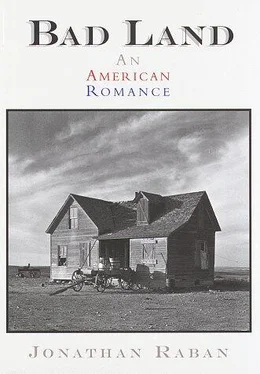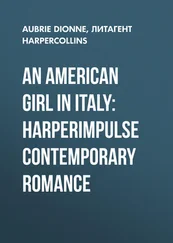There were some shaping features, to which the newcomers would gratefully cling. Fallon Creek, and its inky-green gully of cottonwoods, ran SE — NW. It held the Milwaukee Road line and connected the towns of Ismay and Mildred. Close to the creek, where homesteaders had settled on quarter-section spreads before the passing of the 1909 Congressional bill, one could see the surveyors’ grid beginning to make itself manifest, in tidy squares of land, fenced with barbed wire on twisty posts of juniper. A new gumbo road, the color of sour milk, ran dead straight along the section lines. So long as one stayed close to town, and looked at the land with the prophetic eye of Ismay’s anonymous poet, one could almost see the orderly checkerboard of farms and farm roads. The stern, dependable geometry of Iowa was starting to emerge out of the undifferentiated space of the far West. In a year or two …
But the prophet would falter on the unclaimed benchlands, where the earth lay as wide open as the sky and the wind set up a mournful grumbling in the dry stalks. This was no Iowa. It looked (though one tried to censor this thought) more like the Great American Desert of the Old maps.
The locator pointed out a pile of fist-sized rocks atop a sandstone knoll — a shepherd’s landmark, and not far from the fourth stake. The sight of this lonely cairn wasn’t half as reassuring as the locator intended it to be. It meant that in this country even shepherds were scared of getting lost.
And you? Having beaten the bounds of your new estate, would you ever succeed in finding it again without professional help?
In 1879, Robert Louis Stevenson, traveling on a Union Pacific emigrant train, passed about 320 miles south of here. Looking out at the Plains from the open platform of the car, he was excited by their comfortless monotony.
What livelihood can repay a human creature for a life spent in this huge sameness? He is cut off from books, from news, from company, from all that can relieve existence but the prosecution of his affairs. A sky full of stars is the most varied spectacle that he can hope. He may walk five miles and see nothing; ten, and it is as though he had not moved; twenty, and still he is in the midst of the same great level, and has approached no nearer to the object within view, the flat horizon which keeps pace with his advance … His eye must embrace at every glance the whole seeming concave of the visible world; it quails before so vast an outlook, it is tortured by distance; yet there is no rest or shelter, till the man runs into his cabin, and can repose his sight upon things near at hand. Hence, I am told, a sickness of the vision peculiar to these empty plains.
This sickness — a version of the “calentore” suffered by ocean sailors — was further described by the painter John Noble. In a 1927 interview with a journalist writing for the American Magazine , Noble brought up an incident from his Plains boyhood in the 1870s and early ’80s.
Did you ever hear of “loneliness” as a fatal disease? Once, back in the days when Father and I were bringing up long-legged sheep from Mexico, we picked up a man near Las Vegas who had lost his way. He was in a terrible state. It wasn’t the result of being lost. He had “loneliness.” Born on the plains, you get accustomed to them; but on people not born there the plains sometimes have an appalling effect.
You look on, on, on, out into space, out almost beyond time itself. You see nothing but the rise and swell of land and grass, and then more grass — the monotonous, endless prairie! A stranger traveling on the prairie would get his hopes up, expecting to see something different on making the next rise. To him the disappointment and monotony were terrible. “He’s got loneliness,” we would say of such a man.
The lost traveler of Noble’s story died later that evening. Noble himself made a brief shot at homesteading in Oklahoma, then went to Paris, where he studied painting, and later became famous for his moody seascapes. He explained to his interviewer:
I began to feel that the vastness, the bulk, the over-whelming power of the prairie is the same in its immensity as the sea — only the sea is changeless, and the plains, as I knew, were passing.
Noble might have added that the sea was also a lot easier to paint. Just as the disorienting, oceanic emptiness of the plains could make the traveler sick, so it usually induced a helpless painter’s block. From the mid-nineteenth century onwards, artists began to cross the plains on their way to the supremely picturesque snowcaps, crags, ravines and chiaroscuro light effects of the Rockies. For members of the Hudson River School, like John Frederick Kensett, Sanford Gifford and Worthington Whittredge, the Rocky Mountains represented the summit of the American Sublime. First you conquered Niagara with a paintbrush, then you mounted an expedition to Colorado. These overland western trips led the artists through 700 miles of what appeared to be the least paintable country in the world.
After the scrolled, gleaming surface of the Mississippi, with its wooded bluffs and water traffic (a gift to the luminists), the land began to flatten, and to lose its trees. Soon the traveling artists came into a region with no foreground, no background, no natural frame or lines of perspective. The plains defied the pencil and sketchbook. From the art-school point of view, they were empty of every feature that students had been taught to draw. Even the sky — the big subject of the flat-country landscapist — was a vacant blue, top to bottom, wall to wall. Only when the mountains at last assembled themselves on the horizon, and trees began to sprout beside the trail, were the easels and painting gear unpacked, as the artists reentered a world that could be represented on paper and canvas.
That the plains lay outside the conventions of nineteenth-century picture making is a measure of how intimidating they were to the ordinary traveler and settler. There was no Constable or Corot to give shape and meaning to rural life in this part of the West. Your house and its surrounding land had no precedent in the culture — were beyond every known standard of natural beauty and harmony. The plainsman was condemned to be a visual orphan.
Some artists did try to paint the plains. Albert Bierstadt, who made his first trip to the Rockies in 1859, was a compulsive workaholic. He insisted on making sketches along the way, even when the terrain resisted every attempt at conventional composition. Unable to put his brushes away as the long flat miles unrolled, Bierstadt amassed a pile of mostly formless daubs. But in one oil sketch, Surveyor’s Wagon in the Rocky Mountains , his industriousness was rewarded. The picture is a startling success, and quite outside Bierstadt’s usual range of massive theatrical landscapes.
The title is getting ahead of itself, for we are still a long way short of the Rockies, which stand at a Distance of forty miles or so, pricked out in hazy blue. The surveyor’s wagon is temporarily halted on a sweep of prairie, billiard-table flat, tufted with gray sage. It’s a liquid space, in which the wagon, a loose horse, a rudimentary mounted figure, his arm raised to shield his eyes from the glare, and a small herd of grazing cattle appear to be separately adrift, strung out, at random, across the paper. The painting leads the eye rapidly — too rapidly — from right to left, where it peters out into nothingness. It’s unsettling in exactly the same way as the plains themselves are unsettling: the objects in it are weirdly out of relationship to each other, and to the shining, lakelike ground on which they’re placed.
The painting seems to yearn for the mountains in the far distance. There the rules of composition will apply again. There lies the romantic sublime. There the painter will execute landscapes worthy of the name, with majestic pines, heroic pinnacles, cascades, real lakes, the fantastic play of sunshine and witchy gloom. Somewhere out there, hidden in the haze, is Lander’s Peak — the subject of the painting that Bierstadt would eventually sell to James McHenry, the British railway magnate, for the fabulous price of $25,000.
Читать дальше












